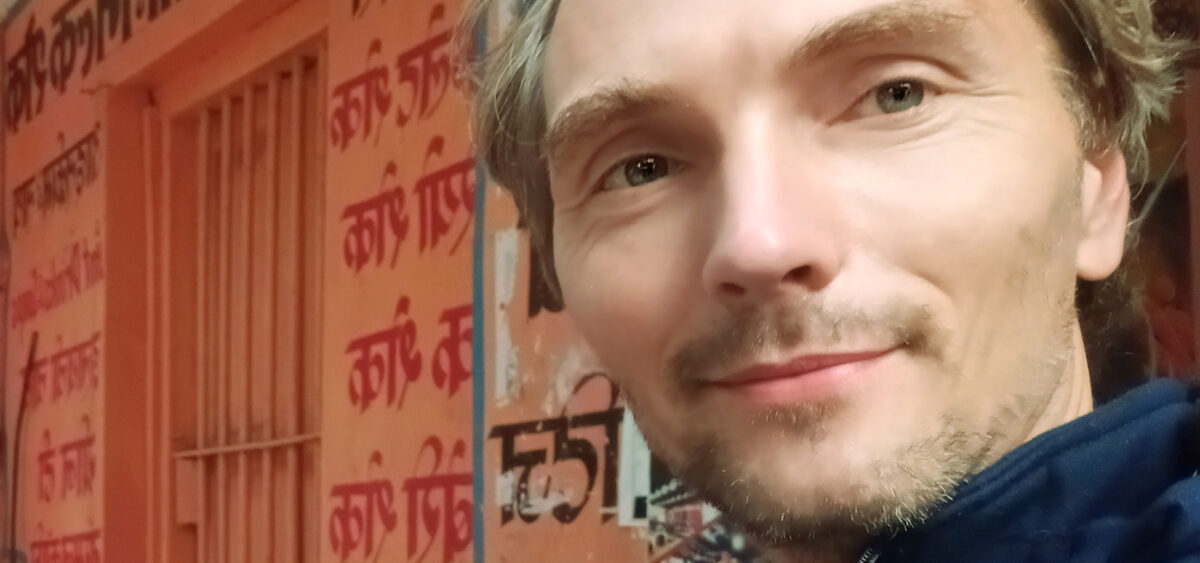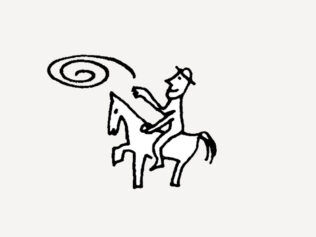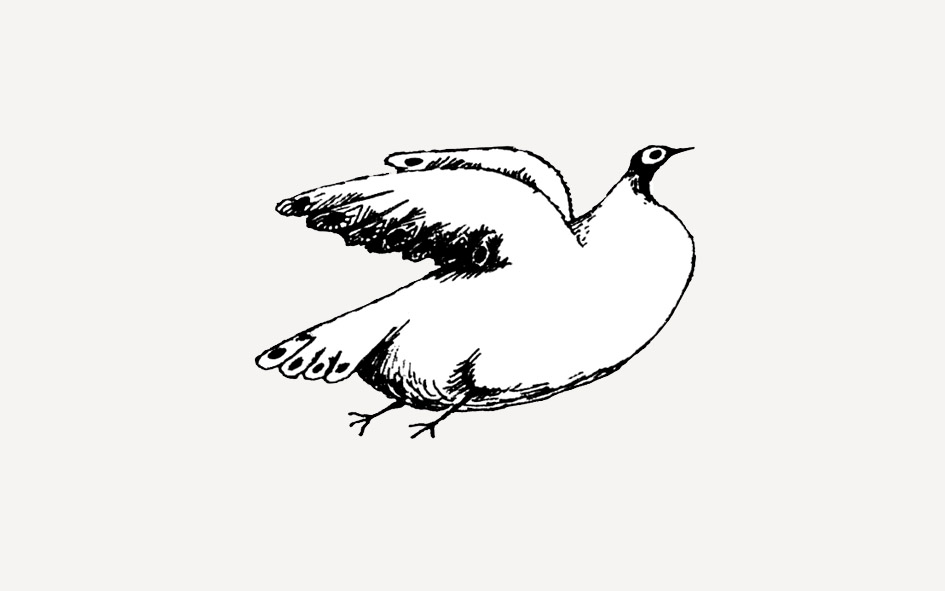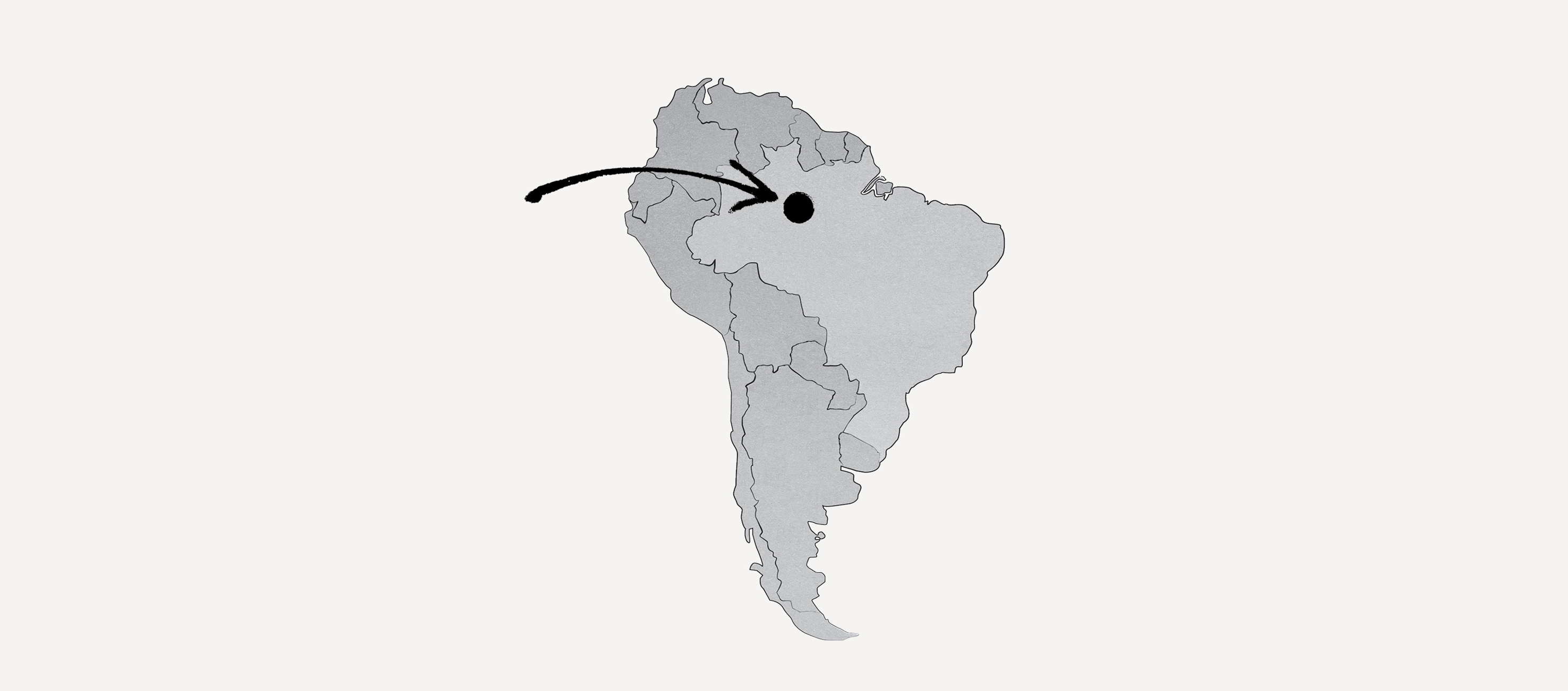
A sacred symbol of the earliest Indian civilization, Sanskrit is still relevant today. Agnieszka Rostkowska speaks with Sanskrit expert and translator Filip Ruciński. Sanskrit is one of the world’s oldest languages—traces of it are found in Akkadian (the language of ancient Babylonia) and it served as a basis for Latin and Greek grammar. One cannot overestimate the impact it has had on world literature and philosophy. Although its accomplishments are already plenty, it lives on and even continues to develop. Agnieszka Rostkowska: Sanskrit remains one of India’s twenty-three official languages, but can you really hear it spoken on the street? Filip Ruciński: Despite general opinion in the West, Sanskrit is not a dead language, nor is it even vegetating. It still has a vital impact on Indian languages—in bureaucratic and academic terminology, both in the humanities and the hard sciences—because it has a great capacity for absorbing new concepts. Moreover, present-day Sanskrit even has loan words from English, which means it is used freely. In other words, it is alive. India still has Vedic schools where the students converse only in Sanskrit—and in literary Sanskrit at that. Monks in many monasteries do the same. One of them was my Sanskrit teacher. He took a vow that he would not speak a word in any other language for ten years. He kept his promise and was even able to converse in stores. There are still places in India where, striking up a conversation with someone on the street in Sanskrit, you can be certain they will understand you and respond in kind. One such example is Sringeri, one of the important Sanskrit centers in the state of Karnataka, in the south of the country. Yet this language is used not only by scholars, but ordinary people as well—in some homes parents still speak and raise their children in Sanskrit. In the 2011 census in India, Sanskrit was declared to be the native language of fewer than 25,000 people. Considering the number of inhabitants of the entire country—1.38 billion—it’s a drop in the bucket. One has to bear in mind that those who speak Sanskrit fluently need not declare it their native tongue. It is hard to get even a ballpark figure for how many people speak it and to what degree of proficiency. It is definitely not the language of the masses. At first glance, it doesn’t appear to be present in public, but taking a closer look, we see it is used, for instance, to spell out the numbers on banknotes. It can be heard on the radio, it is used for the news on the main public television station. The whole DD News channel broadcasts in three language versions: Hindi, English, and Sanskrit. Its Sanskrit edition, Vartavali, is always expanding, developing, and moving with the times—they have organized, for example, competitions for translating contemporary music hits into Sanskrit. The movement to revitalize Sanskrit is also visible in the language courses run by various organizations. The Samskrita Bharati NGO in Bengaluru, in southern India, teaches Sanskrit non-stop: when one course finishes, the next one begins right away. The same is true in Varanasi. Interestingly, even when learning starts from scratch, the language of instruction is always Sanskrit, and that is how foreigners are taught as well. Courses are organized through social initiatives, sometimes co-financed by the government, and there are also purely private initiatives funded by the wealthy—in the eastern state of Odisha, for instance, where people are especially active in spreading Sanskrit. I suppose yoga has had a role in popularizing the language. Of course, the names of the asana, or yoga positions, are in Sanskrit. You can deduce from the name alone what an asana looks like. Sanskrit mantras are still recited in yoga. Sanskrit is also the basis for many scientific disciplines. Ayurveda (an Indian alternative medicine) is entirely based on Sanskrit texts; the same goes for astronomy, astrology, and the natural sciences. Is it correctly thought to be one of the world’s oldest languages? Yes. Sanskrit was the language of the rulers and priests of ancient India, who spoke it to stress their rank, to outside contacts as well. Their civilization was competing with Babylonia, and so Sanskrit even left its trace in Akkadian. There are still documents written by the Kassites, an Indo-European group in Babylonia from the 18th century BCE, in which reference is found to the Indo-Aryan gods, such as Surya, which means “sun” in Sanskrit, Maruta (“wind”), and Buga or Bhaga (“happiness” and “abundance,” an epithet for the sun). The rulers of the Mitanni Empire, which emerged in northern Mesopotamia in the 17th century BCE, bore names that have been traced back to Sanskrit forms, much like other invaders who later conquered Babylonia. There still exists, for instance, a peace treatise from the 14th century BCE between the rulers of the Mitanni and the Hittites that begins by mentioning the Indian gods Indra and Waruna, as well as a Hurrian handbook for training warhorses from the same period that contains several words in Sanskrit, including the numerals. But this language goes even further back, as proven by the Vedas, the oldest group of Hindu sacred texts, written in the most archaic version of Sanskrit. Some indologists claim that they might have been composed in the third millennium BCE, though most date them more cautiously to the 15th century BCE, and their inscription to around the seventh century BCE. Is it because of the Vedas that it is called a holy language? Sanskrit is a holy language because it was spoken by the Rishis—wise men who served as great authorities, such that even the rulers of India sought their favor. The Rishis saw Sanskrit hymns and mantras during meditation—not heard them, but saw them. And when they saw them, they sang them. These songs, in turn, were heard by the Brahmins, who began repeating them and engraved them. Scholars of the language attempted to explain what they mean, which led to the development of the field of Vedic studies. The main body of the Vedas are the Samhitā, collections of hymns to the gods. In Vedic times, Sanskrit was called girvanavani, the “language of the gods.” Vani is literally “beautiful poetic speech, elevated, refined language.” The very word “Sanskrit” etymologically comes from the root kr, meaning “create, make,” and the prefix san, meaning “to do fully, completely.” Sanskrit is literally “done in a complete way.” This term is tied to sanskara, descriptively translated as “a positive trace that will bear fruit in propitious actions and events.” As we can see, Sanskrit terms are difficult to translate, because every word is a multidimensional painting in itself. The most famous literary works of Ancient India, the Rāmāyana and Mahābhārata, are painted like that. Those two epics can be compared to the Iliad and Odyssey. The Odyssey would be the Rāmāyana—it is a kind of royal saga, an epic poem telling the story of Prince Rama, and the work in which the term “Sanskrit” first appears. The Iliad, in turn, would be the Mahābhārata. It has become the epitome of the fratricidal war, and is devoted to the history of the Bharat family. It is a history of India of profound philosophical significance, whose climax is a great battle—everything moves toward it and each of the characters, who are extraordinarily vivid, must choose one side or the other. Is it true that the Rāmāyana and Mahābhārata were passed down orally? Yes, because Sanskrit was initially a spoken language. The oral tradition was so strong that a profession was even made of it—the person working this way remembered the stories of a given family and presented them during family ceremonies, reenacting the fortunes of ancestors. This is why memory of such distant times has survived. These stories were told in a remarkably colorful, even fairy-tale manner; sometimes they included morals for descendants, maybe pointers for how to negotiate a dilemma. Later they were inscribed into epics, still based on true events. That was how the Mahābhārata came to be. And so, for instance, we have the historical names of kingdoms, or janapadas, and in the Rāmāyana there are even detailed descriptions of their borders, the layouts of rivers, and the names of kings. This led archaeologists from the governmental Archaeological Survey of India to Sinauli, where they recently discovered a chariot, and nearby, a mass grave of warriors buried in battle array—just as it was described in the Mahābhārata. Their discovery dates back to the 15th century BCE, which is when this great battle may have occurred. When exactly the epic was composed, however, is unknown, as the manuscripts, which still survive, are copies of older manuscripts. The oldest surviving Sanskrit texts hail from the first or second century BCE. They were found in Turfan, in northwest China, high in the mountains, which have the perfect conditions for manuscripts written on palm leaves to survive 2,000 years. In India, in turn, especially in the south, scribes would copy manuscripts every few centuries or so. That is what makes Sanskrit manuscripts so hard to date. According to one Sanskrit authority, Pierre-Sylvain Filliozat, this language differs from others in that its users always speak it consciously. What does that mean? If a language is used automatically, thoughtlessly, reaching for threadbare and sometimes clumsy comparisons, we use it to be unconscious of what we are saying. With Sanskrit this is impossible, because it was honed through constant reflection on language. When it originally served as a spoken language, its grammar was based on the statements of the Śishta—in modern Sanskrit and Hindi, this word is used for an educated person and is closely related to a term used in Hindi, śiksha, presently meaning “education.” Historically, people who could speak clearly and succinctly were called śishta. They were especially admired for their high competencies in a certain field, such as the greatest doctors, engineers, poets, and artists. It is from their statements that the rules of Sanskrit were extrapolated. Over time, Sanskrit grammar became one of the most perfect works of humanity and a field of study to complement Vedic scholarship. The grammar was recorded in the fourth century BCE by the Indian scholar Pāṇini. To this day he is considered to be a genius. Why? Because he created a meta-language of sorts. Using around 2,000 brief formulae, or sutras—some just two or three syllables long—he encoded the whole of Sanskrit grammar. Pāṇini put together an alphabet, arranging various groups of sounds into “sutra abbreviations.” These formulate the various rules of transforming language with remarkable concision. For example, at the very beginning, two four-syllable sutras encapsulate the rules for vowel transformations; further sutras list exceptions, i.e., when these transformations or alternations do not occur. A similar contribution was made by Pāṇini’s older brother Pingala, to whom we owe the principles of metrics, also contained in sutras. Both were masters of coding long and complicated rules into the most compact forms. They allow someone capable of thinking mathematically and noticing certain patterns to learn Sanskrit quite swiftly. And when you have the grammar, any language is easy. Apparently, learning Sanskrit comes surprisingly easy to Poles. Yes, because Sanskrit has strong ties with the Slavic languages. The basic expressions for consciousness in Polish and Sanskrit sound quite similar—from the Sanskrit source śve (“to shine, be bright”) are derived such Polish words as świadomość (“consciousness”), światło (“light”), and świat (“world”)—the latter in Sanskrit is viśva and literally translates to “diverse shining,” or appearing in various ways. Other Polish words also come from Sanskrit, such as matka (“mother”; in Sanskrit, matr), brat (“brother”; bhrata), siostra (“sister”; svasr), and the numbers dwa, trzy, cztery (“two,” “three,” “four”; dvau, tri, czatvara). When were these affinities first noticed? When Poland began to be interested in India and Indian literature, in the late 18th century. Polish Historian Joachim Lelewel wrote about Sanskrit literature in Dziejach starożytnych Indii [The History of Ancient India], published in 1820. Yet the first person who clearly gave his attention to the fact that Poles speak similarly to people on the other side of the world, in India, was Walenty Skorochód-Majewski, a historian and Sanskrit authority, who described it in O Sławianach i ich pobratymcach [On the Slavs and Their Fraternities], published in 1816. The titular “fraternities” were, of course, Indians. This publication came about in response to the discoveries of the British and Germans, who were looking into the similarities of Latin and their national languages to Sanskrit at the same time. This, in turn, brought about the development of national movements in Europe—various societies saw ties between their native languages and this ancient culture and proudly tried to affirm them. Thus developed Indo-European studies, and later, research into source texts and languages. You and your family have carried on this research. My mother, Anna Rucińska, translated a great many Sanskrit texts into Polish, including the Bhagavad Gita, which is part of the Mahābhārata, as well as the vital first book of the Rāmāyana, never before translated into Polish, and the allegorical tale of the goddess Durga. My father, Tomasz Ruciński, lectured in Sanskrit and Indian philosophy at the Catholic University of Lublin. This meant Sanskrit was our family treasure, and also simply a part of our lives. When I began elementary school, my father told my brother and I that we would be having lessons on Saturday mornings as well. Every week he sat us down at the table and taught us Sanskrit for three hours. At first there were three subjects: Yoga sutras, the Bhagavad Gita, and Pāṇini’s grammar, which meant I later had no problem with Polish grammar. My sister sometimes joined in—not so regularly, because she always caught on right away. Year after year, my father changed the subjects. So at home we all know Sanskrit. My brother and I speak it fluently; we also studied at Sampurnanand University in Varanasi. That’s one of the most renowned academies for learning Sanskrit. Yes, it was founded in 1791—initially as Government Queen’s College—by the British, who employed the greatest Indian scholars, brahmins, and pandits (a scholar specialized in the various fields of Hinduism) there to teach them Sanskrit and Indian culture, sharing their manuscripts as well. After India gained independence, those brahmins and pandits carried on developing the university themselves. In 1974, they changed the name to Sampurnanand Sanskrit University. At present, not only Indians study there, but also people from around the world. Do Indian children now learn Sanskrit at school? Yes, but it is an elective subject, and mostly disliked—students have to cram paradigms and declensions without delving into the essence of Sanskrit, the literature, and the whole cultural context. The language is also underfunded—there have even been protests in Odisha, because for the past ten years not a single new position for Sanskrit teachers has been created there, while posts for teachers of mathematics and other subjects have quadrupled. And Sanskrit scholars can practically only find employment as teachers. There is also a lack of funding for translations of Sanskrit works. Is it true that one of the key ancient works, the Nātya Śāstra, has yet to be translated into Western languages? It has only been translated into English and Hindi. It is a five-volume theory of theater and is of universal significance. Its subject is the variety of theaters across the vast territory of India, and thus it shows new perspectives that could serve as a point of departure for pondering European theater and cinema. Yet no Indian institution has funded its translation, because the Nātya Śāstra is an academic work, not a commercial one. Not even the Bharatiya Janata Party government? The BJP, in power since 2014, began making their vows in parliament in Sanskrit and are great promoters of the language. Yes, but they do so in an instrumental way, to strengthen their position—to demonstrate that they possess a heritage that was a source of culture around the world. This is also why the BJP supports only some initiatives tied to Sanskrit, while many fields remain untouched. Sanskrit brahmins and scholars keep their distance from politics. They try to maintain neutrality, stressing that Sanskrit should not serve any one political option, because it is, by definition, beyond all divisions—it is the language of holy texts, whose wisdom allows you to know your soul as part of the highest consciousness, the Absolute. As such, Sanskrit should guide us toward unity and the recognition that each of us is like a wave that need not strive to separate from the ocean, because it knows that, from the beginning, it was, is, and will be a part of it. And so it may stay calm. Parts of this interview have been edited and condensed for clarity and brevity.
Photo from the private archive of Filip Ruciński
Filip Ruciński:
An indologist, Sanskrit scholar, and yoga teacher with a PhD in Literary Studies. Council chair of the Vivaswan Foundation, whose aim is to spread knowledge about Indian culture. Translated from the Polish by Soren Gauger










